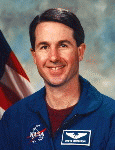| RSC
Energia bio |
 Stephen
K. ROBINSON Stephen
K. ROBINSON
ISS Flight Engineer-1;
NASA Astronaut
BIRTH DATA AND PLACE: October 26, 1955, Sacramento, California, USA.
His parents, William and Joyce Robinson, reside in Moraga, California.
EDUCATION:
Received a bachelor of science degree in mathematics/aeronautical engineering
from University of California at Davis, in 1974; a master of science degree
and then a doctorate in mechanical engineering, with a minor in aeronautics
and astronautics from Stanford University, in 1985 and 1990, respectively.
MARITAL STATUS: unmarried.
ORGANIZATIONS:
American Institute of Aeronautics and Astronautics;
Aerospace Medical Association;
Experimental Aircraft Association.
SPECIAL HONORS:
NASA Ames Honor Award for Scientist (1989);
American Institute of Aeronautics and Astronautics Outstanding Technical
Paper Award for Applied Aerodynamics (co-author) (1992);
NASA/Space Club G.M. Low Memorial Engineering Fellowship (1993).
HOBBIES: Enjoys flying, antique aircraft, swimming, canoeing, hiking,
music, art, and stereo photography. Plays lead guitar in Max Q, a rock-n-roll
band.
EXPERIENCE:
Robinson started work for NASA in 1975 as a student co-op at NASA's
Ames Research Center in Mountain View, California, which he joined in 1979
as a research scientist upon graduation from University of California at
Davis. He performed studies in the fields of fluid dynamics, aerodynamics,
experimental instrumentation, and computational scientific visualization.
While at Ames, Robinson earned master's and doctor's degrees in mechanical
engineering from Stanford University.
In 1990, Robinson was selected as Chief of the Experimental Flow Physics
Branch at NASA's Langley Research Center in Hampton, Virginia.
In 1993, he was awarded the NASA/Space Club Low Memorial engineering
fellowship and was assigned as a visiting engineer to the Massachusetts
Institute of Technology where he worked in the Man Vehicle Laboratory (MVL)
for 15 months. He conducted neurovestibular research on astronauts of the
STS-58 crew who were being trained under the Spacelab Life Sciences 2 program.
His other research included EVA dynamics for satellite capture and space
construction. While in Cambridge, Massachusetts, he was a visiting scientist
at the U.S. Department of Transportation's Volpe National Transportation
System Center.
Robinson returned to NASA Langley Space Center in September 1994, where
he accepted a dual assignment as research scientist in the Multidisciplinary
Design Optimization Branch, and as leader of the Aerodynamics and Acoustics
element of NASA's General Aviation Technology program.
Robinson has logged over 1400 hours in different aircraft types ranging
from antique taildraggers to NASA jets.
Selected as NASA candidate astronaut in December 1994, upon completion
of one-year training at the Johnson Space Center, he was assigned to test
space shuttle control software in the Shuttle Avionics Integration Laboratory
(SAIL).
Dr. Robertson attended two space flights. He has logged over 496 hours
in space.
On August 7-19, 1997 Robinson took his first space flight as a mission
specialist of the Discovery crew (STS-85). The crew deployed and retrieved
the CRISTA-SPAS payload designed to study the Earth's atmosphere, as well
as tested some technologies destined for ISS, in particular, the experimental
Japanese robot arm. Mission duration was 11 days 19 hours and 18 minutes.
From October 29 to November 7, 1998, he took his second flight as a
Payload Commander of the Discovery crew (STS-95) with the SPACEHAB pressurized
module in the shuttle cargo bay. During the mission the crew deployed the
Spartan solar-observing spacecraft, and the Hubble Space Telescope Orbital
Systems Test Platform, and performed a large scope of investigations. Mission
duration was 8 days 21 hours and 44 minutes.
In February 1999, Robinson was assigned as the Astronaut Office representative
for the ISS Robot Arm, as well as a Capcom (Spacecraft Communicator, functioning
as the voice link between MCC-Houston and Shuttle).
In July 1999, he was assigned as backup crewmember for the International
Space Station Expedition 4 crew.
In August 2001 Robinson was assigned to the STS-114 crew scheduled
to launch at the end of 2002.
August 2001.
Based on NASA Lyndon B. Johnson Space Center materials (USA). |
|



 Stephen
K. ROBINSON
Stephen
K. ROBINSON